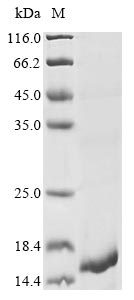Recombinant Naja atra Cytotoxin 2 is produced using an E. coli expression system and contains the complete mature protein spanning amino acids 22 to 81. The engineered protein includes an N-terminal 10xHis-tag and a C-terminal Myc-tag, which makes purification and detection more straightforward. SDS-PAGE verification shows the product reaches purity levels above 85%, making it suitable for research work.
This cytotoxin comes from Chinese cobra venom and belongs to the three-finger toxin family. These proteins are particularly interesting because they can interact with cell membranes. Scientists find them valuable for studying how proteins bind to membranes and for exploring cell signaling pathways that might lead to new treatments.
Potential Applications
Note: The applications listed below are based on what we know about this protein's biological functions, published research, and experience from experts in the field. However, we haven't fully tested all of these applications ourselves yet. We'd recommend running some preliminary tests first to make sure they work for your specific research goals.
Based on the provided information, the recombinant cytotoxin 2 protein is unlikely to be correctly folded or bioactive without experimental validation. Cytotoxins are small, highly structured proteins that require precise disulfide bond formation for their three-finger fold structure and membrane-interacting function. The E. coli expression system lacks the eukaryotic machinery for proper disulfide bond formation and may not support correct folding of this toxin. The dual tags (N-terminal 10xHis and C-terminal Myc) are particularly problematic for a small protein (60 amino acids), as they may constitute nearly half the molecular weight and severely disrupt the native structure. The purity >85% indicates some impurities, but does not guarantee correct folding.
This recombinant cytotoxin can generate antibodies, but they will primarily recognize the immunodominant tags rather than native cytotoxin epitopes. If misfolded, antibodies may not recognize the physiological toxin. For specific antibodies, use tag-free, properly folded cytotoxin and validate against native venom components. The Myc tag provides a detection control but compromises antigen authenticity.
This recombinant cytotoxin 2 requires extensive validation before any functional application. Priority should be given to: 1) Removing both tags via proteolytic cleavage and purifying the tag-free protein; 2) Validating correct folding through circular dichroism to confirm the characteristic β-sheet pattern of three-finger toxins; 3) Verifying disulfide bond formation via mass spectrometry; 4) Confirming bioactivity with cytotoxicity assays on relevant cell lines. If native folding cannot be achieved, consider alternative expression systems (e.g., eukaryotic systems with oxidative folding capacity) or use purified native toxin from venom for critical studies. For antibody development, if using this protein, thoroughly characterize antibodies against venom-derived cytotoxin to ensure specificity.






